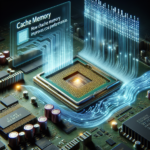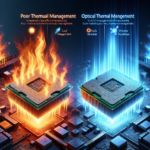Explaining the Role of Cache Memory in CPU Performance

Explaining the Role of Cache Memory in CPU Performance
In the realm of computer architecture, cache memory plays a pivotal role in enhancing the performance of the Central Processing Unit (CPU). As modern applications demand more processing power and speed, understanding the intricacies of cache memory becomes essential. This article delves into the significance of cache memory, its types, and how it impacts CPU performance.
What is Cache Memory?
Cache memory is a small, high-speed storage component located close to the CPU. It stores frequently accessed data and instructions, allowing the CPU to retrieve this information quickly. By reducing the time it takes to access data from the main memory (RAM), cache memory significantly boosts the overall performance of the CPU.
Types of Cache Memory
Cache memory is typically categorized into three levels:
- L1 Cache (Level 1): This is the smallest and fastest cache, located directly on the CPU chip. It is divided into two parts: the instruction cache and the data cache. The L1 cache is designed to provide the CPU with the most frequently used data and instructions.
- L2 Cache (Level 2): Slightly larger and slower than the L1 cache, the L2 cache is also located on the CPU chip or on a separate chip close to the CPU. It serves as an intermediary between the L1 cache and the main memory, storing data that is not as frequently accessed as the data in the L1 cache.
- L3 Cache (Level 3): The L3 cache is larger and slower than both the L1 and L2 caches. It is shared among multiple CPU cores and acts as a last-level cache before the data is fetched from the main memory. The L3 cache helps to reduce the latency associated with accessing data from the main memory.
How Cache Memory Works
Cache memory operates on the principle of locality of reference, which includes temporal locality and spatial locality:
- Temporal Locality: This principle states that recently accessed data is likely to be accessed again in the near future. Cache memory leverages this by storing recently used data for quick retrieval.
- Spatial Locality: This principle suggests that data located close to recently accessed data is also likely to be accessed soon. Cache memory stores blocks of data, ensuring that nearby data is readily available.
When the CPU needs to access data, it first checks the cache memory. If the required data is found in the cache (a cache hit), the CPU retrieves it quickly. If the data is not found (a cache miss), the CPU fetches it from the main memory, which takes more time. The fetched data is then stored in the cache for future use.
The Impact of Cache Memory on CPU Performance
Cache memory significantly influences CPU performance in several ways:
Reduced Latency
By storing frequently accessed data and instructions, cache memory reduces the time it takes for the CPU to retrieve this information. This reduction in latency leads to faster execution of tasks and improved overall performance.
Increased Throughput
With quick access to data, the CPU can process more instructions in a given period. This increased throughput enhances the efficiency of the CPU, allowing it to handle more complex tasks and applications.
Improved Multitasking
Cache memory enables the CPU to switch between tasks more efficiently. By storing data from multiple tasks, the CPU can quickly access the required information, reducing the time spent on context switching and improving multitasking performance.
Energy Efficiency
Accessing data from cache memory consumes less power compared to fetching data from the main memory. This energy efficiency is particularly important in mobile devices and laptops, where battery life is a critical factor.
Factors Affecting Cache Performance
Several factors influence the performance of cache memory:
Cache Size
The size of the cache memory determines how much data it can store. Larger caches can store more data, reducing the likelihood of cache misses. However, larger caches also consume more power and may have higher latency.
Cache Associativity
Cache associativity refers to how cache lines are mapped to main memory addresses. Higher associativity reduces the likelihood of cache conflicts, where multiple data items compete for the same cache line. However, higher associativity can also increase the complexity and latency of the cache.
Cache Replacement Policies
When the cache is full, a replacement policy determines which data to evict to make room for new data. Common replacement policies include Least Recently Used (LRU), First-In-First-Out (FIFO), and Random Replacement. The choice of replacement policy can impact cache performance.
Cache Coherency
In multi-core processors, cache coherency ensures that all CPU cores have a consistent view of the data. Cache coherency protocols, such as MESI (Modified, Exclusive, Shared, Invalid), help maintain data consistency but can introduce additional overhead.
Optimizing Cache Performance
To maximize the benefits of cache memory, several optimization techniques can be employed:
Prefetching
Prefetching involves fetching data into the cache before it is actually needed. By predicting future data accesses, prefetching can reduce cache misses and improve performance. However, incorrect predictions can lead to unnecessary data being loaded into the cache, wasting space and bandwidth.
Cache Partitioning
Cache partitioning divides the cache into separate sections for different types of data or tasks. This can reduce cache conflicts and improve performance in multi-core processors. For example, one partition can be dedicated to instructions, while another is used for data.
Cache Compression
Cache compression reduces the size of data stored in the cache, allowing more data to fit in the same space. This can reduce cache misses and improve performance, but it also introduces additional complexity and latency due to the compression and decompression processes.
FAQ
What is the primary purpose of cache memory?
The primary purpose of cache memory is to store frequently accessed data and instructions close to the CPU, reducing the time it takes to retrieve this information and improving overall CPU performance.
How does cache memory differ from main memory (RAM)?
Cache memory is smaller, faster, and located closer to the CPU compared to main memory (RAM). While RAM stores a larger amount of data, cache memory stores only the most frequently accessed data to provide quick access and reduce latency.
What are cache hits and cache misses?
A cache hit occurs when the CPU finds the required data in the cache memory, allowing for quick retrieval. A cache miss occurs when the data is not found in the cache, requiring the CPU to fetch it from the main memory, which takes more time.
Why are there multiple levels of cache (L1, L2, L3)?
Multiple levels of cache provide a balance between speed and size. The L1 cache is the fastest but smallest, while the L3 cache is larger but slower. This hierarchy ensures that the most frequently accessed data is retrieved quickly, while less frequently accessed data is still stored relatively close to the CPU.
How does cache memory improve multitasking performance?
Cache memory stores data from multiple tasks, allowing the CPU to switch between tasks more efficiently. This reduces the time spent on context switching and improves overall multitasking performance.
Conclusion
Cache memory is a critical component in modern computer architecture, playing a vital role in enhancing CPU performance. By storing frequently accessed data close to the CPU, cache memory reduces latency, increases throughput, and improves multitasking capabilities. Understanding the different types of cache memory, how they work, and the factors affecting their performance is essential for optimizing CPU performance. As technology continues to evolve, advancements in cache memory design and optimization techniques will further enhance the efficiency and speed of CPUs, meeting the growing demands of modern applications.




